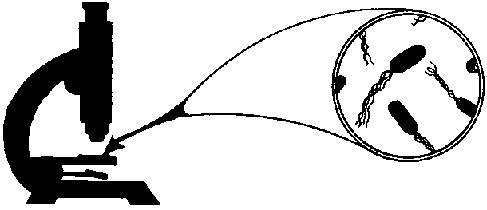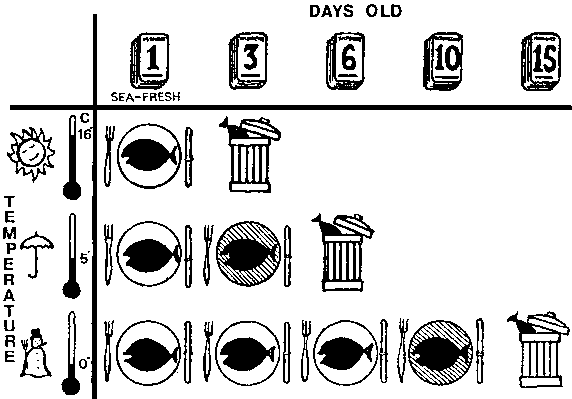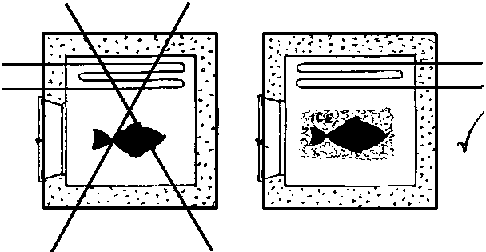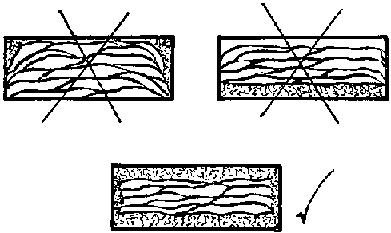Why fish go bad
Where bacteria come from
The effect of temperature
Keeping fish cool
How to handle the fish
Cleanliness and hygiene
Fish go bad because of bacteria that grow on and in them. Bacteria are tiny living organisms that occur everywhere in nature, and are an essential part of the endless chain of life. They are so small that even the largest is visible only with the aid of a powerful microscope. A piece of stale fish about the size of a 10p coin would harbour many millions of these.
The bacteria break down the complicated chemical compounds in fish flesh into simpler substances. If fish die in the sea, the flesh is decomposed into these simple substances which are hence made available again to other life in the sea. When the dead newly caught fish are to be used as human food, this natural process must be slowed down as much as possible by limiting bacterial action.
One of the kinds of Bacteria that make fish go stale magnified approximately 4,000 times

Bacteria occur naturally on the skin and in the slime of living fish, where they do no harm. They are also found in large numbers in food in the guts of fish. These bacteria do not affect the flesh of the living fish, but very soon after they die, the bacteria begin to attack them. Bacteria in the mud on the sea bottom may also get on the fish while they are in the net, and further contamination may occur from the deck of the fishing vessel, the fish room and the crew handling the catch. The baskets used for landing them, the market boxes or kits, the hands of the handlers and processors, all of these can further contaminate the fish.
No matter how carefully the fish are gutted, washed and stored, some of the bacteria will inevitably remain on the skin and in the bellies. These will continue to multiply from the time that the fish are first caught until they are cooked and eaten. Quick freezing followed by low temperature storage, and some other methods of preservation, would reduce or even halt bacterial activity, but during chilled storage of wet fish, as in ice, this activity continues to flourish. The numbers of bacteria can be kept down by making sure that every surface that the fish touch is kept scrupulously clean.
The speed with which bacteria grow depends on temperature, and indeed temperature is the most important factor controlling the speed at which fish go bad.
Cod kept at 0°C, the melting point of ice, will be virtually uneatable after fifteen days. Cod kept at 4°C, however, will probably be unfit to eat after only six days. At 16°C they could be condemned after one or two days.
The effect of temperature on the keeping qualities of fish.

The higher the temperature, the faster the fish go stale. It might be thought therefore that the best thing to do is to store fish at a temperature somewhat lower than that of melting ice. This is not practicable for fresh fish, however, since the flesh begins to freeze slowly at about - 1°C. Slow freezing has a very bad effect on the quality of the fish and should be avoided. Quick freezing by which the fish is cooled rapidly to a very much lower temperature is a different matter.
The most satisfactory way of keeping fish cool and hence slowing down spoilage is to use melting ice.
Although there are other ways of cooling fish, for example by cold air, or 'dry ice' (solid carbon dioxide), these are not nearly as good as ice.
If cold air alone is used, as in a chill room, the heat taken from the fish will warm the air rapidly. The warm air must then be removed by using a fan and cooled again. Large quantities of cold air blown across the surface of the fish dry them so that they quickly lose their moist, attractive appearance. Also the cold air doesn't easily penetrate beneath the top layers of fish. The warmth in the centre of the heap of fish passes very slowly indeed through the outer layers to the cold air outside, and thus the fish in the middle may in consequence take a very long time - hours or even days - to cool down.
It might be thought, however, that dry ice, since it is much colder than ordinary ice, would cool fish very well. Dry ice again cannot however be mixed intimately with the main mass of fish as can ordinary ice. It has to be kept apart from the fish because of its very low temperature (- 80°C) otherwise the fish freeze, and the cooling hence has to be done indirectly by the cold air produced. Cooling is thus less efficient; the cost of removing the same amount of heat from fish by means of dry ice is also much higher than the cost of ordinary ice to do the same job.
All ordinary ices, no matter how or where they are made, have the same cooling ability, weight for weight. There is no difference in the efficiency of ice made from different water supplies or in different countries. The same amount of heat is always required to melt a pound of ice. The temperature of any remaining ice and its melt water cannot rise until all the ice has melted. Ice in a partially melted state has obviously already lost some of its cooling capacity. Fresh ice should be firm, crisp and dry not wet and slushy.
Chilled fish, stored so that ice is in close contact with every fish, will remain at ice temperature as long as some of the ice still remains.
Ice is the best agent for cooling warm fish, and then keeping them cool. Once the fish have reached ice melting point, the remaining ice can be prevented from running away too quickly by putting the iced fish into a chill room or insulated store. The insulation will keep out much of the unwanted heat which would otherwise melt some of the ice intended to cool the fish.
Cooling grids in the chill room will reduce the air temperature and so slow down the rate of ice meltage, but care must be taken that the ice is not kept so cold that it cannot melt at all, since if it doesn't melt, partial freezing can occur, and the fish will lose the sleek glossy appearance that is normally produced by the melt water and which the industry regards as so important.
Ice cold melt water removes heat from the fish effectively because it comes into immediate contact with all parts of the fish. The ice must therefore be free to melt, however slowly.
The use and misuse of chill rooms.

The temperature of fish from the time they are landed until they reach the customer has been measured on many occasions. This work has shown that the places where the most severe rises in temperature occur are at the port markets before filleting and dispatch, at inland markets awaiting distribution, and in the retail shops.
When the fish are landed from the vessel, their temperature is very close to that of ice in which they have been stored on board.
As soon as they are received from the first sales, if they are not to be filleted or otherwise processed at once, then the fish should be well and properly iced. The hour or two that the fish may have to await processing can be damaging to their quality. Keep them cool.
In summer, chill the water in the filleting troughs by adding ice. Do the same in winter if it is not too uncomfortable for the filleters, since tap water stays at much the same temperature in winter and summer.
Cool the fillets in ice cold water before packing them. Put ice at the bottom of the box, and again on top of the fillets. Top icing alone is not good enough, and ice at the ends of the boxes only is of very little value at all. Inspection and further topping up with ice may be advisable if there is a long wait between packing and dispatch.
Whole fish being sent away should be similarly treated, putting ice at top and bottom.
When boxes are loaded into rail or road vans, a sprinkling of ice over and around the boxes will help to get the fish to the other end in as good condition as possible.
Remember that insulation helps to keep heat either in or out. If warm fish are loaded into a warm insulated van, inadequately iced, then the insulation will help to keep those fish warm, not cold. The fish must be already cool at loading, then the insulation can protect them and keep them cool. Insulation can help make it easier to maintain a low temperature, but it can do nothing to cool something that is already warm.
How to ice a box of fillets.

Once fish have become warm somewhere along the chain, it is extremely difficult to bring the temperature down to an acceptable level again. It is very much more satisfactory to keep the fish cool from the beginning.
Boxes awaiting resale or distribution at inland markets should be examined and re-iced where necessary. They should not be left standing exposed to warm air. If a long wait is likely, put them in a chill or at least a cool place to prevent the remaining ice from running away before the fish are unpacked.
In the retail shop, do not rely on uncooled slabs for display, nor even on refrigerated display units alone. Ice is as necessary here as at all other points along the chain, for fish on a mechanically cooled surface without ice may still have warm, dry air passing over the surface, to the detriment of the product. Ice among the fish on the slab will keep them cool, prolong the shelf life and add to their appearance. If fish are being stored away for the night, ice them well, do not rely on the cold air in the holding cabinet or chill to give them adequate protection.
All surfaces that may come into contact with fish must be kept thoroughly clean to prevent contamination of the fish by spoilage or disease causing bacteria. Complete cleanliness involves the removal of the dirt so that the surface looks clean, by using a detergent, then killing any remaining bacteria by using a disinfectant or sterilising agent.
For complete cleaning, firstly loosen the dirt by washing with detergent and hot water. Then remove the dirt by scrubbing or with a powerful water jet.
Lastly, kill remaining bacteria by using steam or a suitable chemical disinfectant.
All surfaces should be rinsed thoroughly after the use of detergents and disinfectants to prevent corrosion and to avoid the contamination of foodstuff's.
Personal hygiene is important. Hands should be kept clean at all times, and washed after every visit to the toilet. Hair should be kept covered if possible, and protective clothing worn. Protective clothing should be kept clean.
Manufacturers' instructions should be closely followed when detergents and disinfectants are being used, since wrong application, or wrong strength, may do harm.
Detailed information on most aspects of fish handling and
processing may be found in the publications of Torry Research Station.